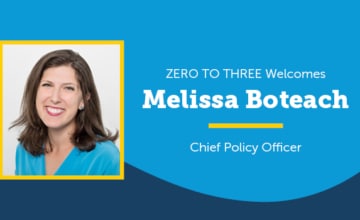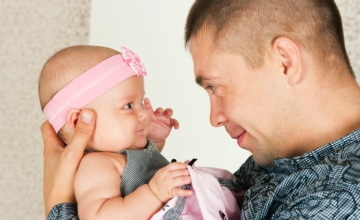Dorinda Silver Williams, Georgetown University Center for Child and Human Development, Washington, DC
Kathleen Mulrooney, ZERO TO THREE, Washington, DC

Abstract
This article focuses on the fundamental role that early childhood educators (ECEs) play in the lives of infants and very young children and their families—underscoring the power of early interactions and relationships between infant–toddler and preschool educators and the children in their programs. The authors explore the ECEs’ unique roles, perspectives, and skillsets that lend themselves, not only to working directly with the young ones in their care, but also for supporting families under stress as an opportunity to mitigate relational risks and foster intergenerational resilience. From a parallel perspective, the authors also address the critical need to foster the health and wellness of ECEs so that they, in turn, have optimal capacity to be fully responsive to the children and families they support.
The early years are a period of extraordinary growth across developmental domains. These developmental realms are inextricably linked and informed by a complex interplay among genetic substrates, biological processes, and early relational experiences (Bowlby, 1988; Coan, 2010; Siegel, 1999). Each of these developmental realms works in concert to lay the groundwork for optimal health and development across the lifespan.
At the cornerstone of this rapid, multidimensional, and foundational early development is the burgeoning capacity for social and emotional wellness associated with infant and early childhood mental health (IECMH). While this term, IECMH, can evoke troubling images of babies in psychological distress, the conceptualization of IECMH is far more complex, nuanced, and expansive. Indeed, society’s collective recognition of infants and toddlers’ mental health is paramount to understanding, honoring, and, ultimately, safeguarding the young children’s internal world and promoting healthy attachments and relationships.
ZERO TO THREE defined IECMH as “the developing capacity of the child from birth to 5 years old to form close and secure adult and peer relationships; experience, manage, and express a full range of emotions; and explore the environment and learn—all in the context of family, community, and culture” (ZERO TO THREE Infant Mental Health Task Force Steering Committee, 2001). This definition highlights the essential role of regulatory capacity, social influences, and cultural context in fostering young children’s evolving ability to form healthy relationships. Infants and young children are born into this world with their brains literally “wired” to form relationships. The ability to establish healthy attachment relationships with their primary caregivers (typically parents) is paramount to young children thriving and surviving in the world. From the perspective of attachment theory, these secure relationships, in turn, advance opportunity for rich play and exploration that supports development and learning.
Attachment Theory
Attachment theory is predicated on the belief that the caregiving milieu serves as a control system, in which babies and toddlers move away from, or closer to, their attachment figures, for fulfilling their physical, emotional, and developmental needs (Bowlby, 1969/1982, as cited in Vaughn & Waters, 1990; Bowlby, 1988; Waters, 2008). Infants and toddlers who, for the most part, experience responsive, sensitive, and attuned caregiving, are likely to use their parents and caregivers as a “secure base” from which to exuberantly and confidently explore their environment—knowing they can loop back to their trusted caregivers, as needed, for protection, emotional nurturance, and reassurance. (Note: The term “caregiver” will be used throughout this article to include parents, family members, and any other adults who play a caregiving role in the lives of a young child.) Over time, infants and toddlers internalize this felt security, adopting a secure attachment to their caregiver that contributes to an adaptive emotional template, or “internal working model,” for how they experience themselves, relationships, and the world around them. (Ainsworth et al., 1978; Bowlby, 1988).
On the other hand, for young children whose caregiving is marked by chronic distress, conflict, maltreatment, emotional unavailability, misattunement, loss of their attachment figure, or a combination of these, their view of the world and of themselves in the world is likely to be compromised. Their inability to use their attachment figures for physical and emotional safety may contribute to maladaptive relational patterns, insecure attachment, and risk factors associated with poor or compromised developmental outcomes (Ainsworth et al., 1978; Green et al., 2007).
Caregivers’ struggles to optimally respond to their infants and toddlers are often influenced by their own distress, including experiences, interactions, dynamics, and relational representations from the past that interfere with the present. These psychic wounds, as named in the classic literature “ghosts in the nursery” (Fraiberg et al., 1975), can wreak havoc on intergenerational relationships by undermining caregivers’ parental confidence; hijacking parental regulatory capacity; and invoking unexamined experiences that threaten to flood the nursery with unresolved, triggering emotions.
Fortunately, caregivers’ memories of early nurturing, responsive, and attuned experiences can be invoked and leveraged to help mitigate the risk of intergenerational adversity. The benevolent presence of these “angels in the nursery” (Lieberman et al., 2005) can serve as a critical counterpoint to the “ghosts” from the past who threaten to encroach on developing relationships in the present (Fraiberg et al., 1975). Beckoning forgotten or unacknowledged memories of loving and responsive interactions can foster more balanced, corrective, and integrative representations of early relationships that may contribute to caregivers’ capacity to hold complexities and imbue parental interactions with warmth and tenderness for their own children (Lieberman et al., 2005).
While the angels in the nursery are described as beneficent caregiving interactions from the past, loving and responsive moments in the present can also serve as agents of multigenerational change and healing. The authors suggest that benevolent spirits embedded in the professional realm appear every day in the humble, material form of daily acts of care, sensitivity, and responsiveness engendered by dedicated helpers.
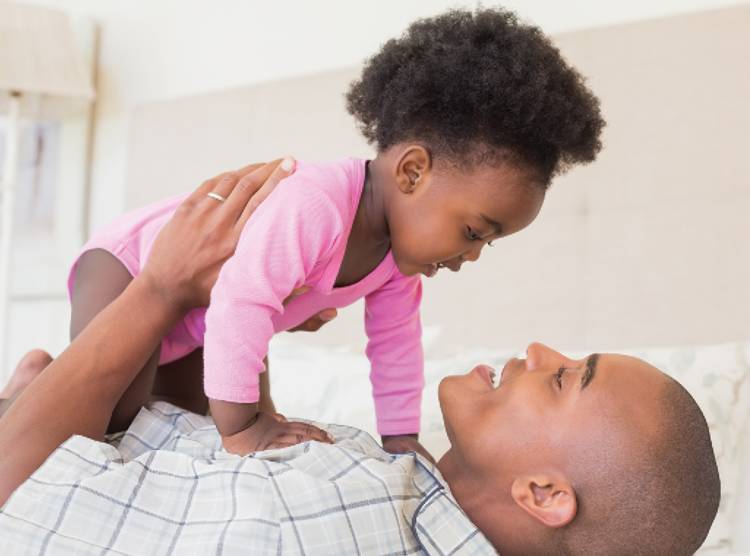
The ability to establish healthy attachment relationships with their primary caregivers (typically parents) is paramount to young children thriving and surviving in the world. Photo: wavebreakmedia/shutterstock
Early childhood educators (ECEs), in particular, have a unique opportunity to cultivate tender ministrations that serve as protective and powerful guardians for the children in their care; these unsung heroines and heroes inhabit the delicate space between the normative bounds of professionalism and the inherently personal, intimate task of nurturing young children into their optimal selves.
The Role of the ECE in Promoting IECMH
ECEs play a pervasive, essential, and comprehensive role in the lives of very young children and their families. Given the high need for child care in the US, and the many recognized benefits of early childhood education, many young children are under the care of ECEs. Furthermore, the time that young children spend in early childhood education can be substantial. According to the U.S. Census Bureau (Laughlin, 2013), 12.5 million (61%) of the 20.4 million children under 5 years old were in some kind of regular early childhood education arrangement during a typical week in the spring of 2011. Preschool children of employed mothers in spring 2011 spent an average of 33 hours per week at center-based programs and 32 hours in family child care homes (Laughlin, 2013). The amount of time that preschoolers spend in nonfamilial early childhood settings further underlines the influential role that ECEs play in the lives of infants and young children.
Early Childhood Education Providers and Attachment
How significant might the ECE–child relationship be? In a study by Sagi et al. (1995), the authors examined the nature of attachment between professional caregivers on kibbutzim in Israel, and the young children in their charge. The findings suggest that young children can form multiple attachments, including with non-familial caregivers. While the differences between non-familial early childhood education in the US and kibbutzim caregivers should be taken into consideration, these findings suggest that ECEs can provide and promote early attachments and make a lasting imprint on the lives of the children in their care.
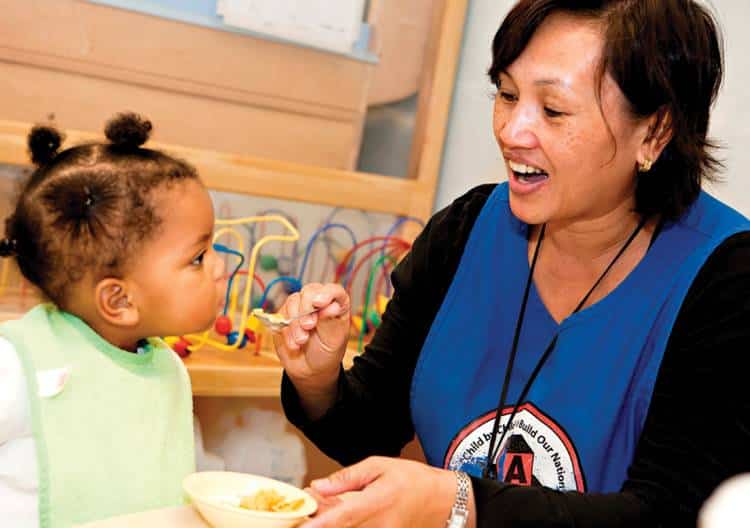
Given the high need for early childhood education in the US, and the many recognized benefits of early childhood education, many young children are under the care of early childhood education providers. Photo: ZERO TO THREE
Multiple Roles
While ECEs’ primary responsibility is to tend to the basic needs of the children in their charge, the complexity of those needs warrant supports across multiple fronts and roles. Indeed, qualitative studies suggest a multitude of roles that ECEs occupy. ECEs have identified themselves as teachers, social workers, caregivers, and business owners (Fernandez et al., 2018; Sisson et al., 2017). In addition to these broad roles, ECEs have delineated core functions of their work, such as modeling kindness, keeping children safe, readying children for school, and providing both physical and emotional nurturance (Sisson et al., 2017). While these roles might vary by settings and circumstances, this list gives a glimpse of the tangle of tasks and responsibilities that ECEs manage on a daily basis. The National Association for the Education of Young Children (NAEYC) described the primary responsibilities of the ECE as “initiating and sustaining respectful and reciprocal relationships with children’s families and other caregivers; they work with them to support young children’s positive development both inside and outside the early learning setting” (NAEYC, 2019, p. 14). This delineation of ECEs’ responsibilities is embedded in an overarching effort to define and codify professional standards, competencies, ethical conduct, and other foundational elements to guide ECE practice and govern the field.
ECEs have a unique vantage point from which to observe and reflect on the needs, strengths, and concerns of the parents and families in their programs. From a parallel process perspective, safeguarding the continued health and well-being of infants and toddlers is contingent on safeguarding the health and well-being of their families. Drop-offs, pick-ups, parent–provider meetings, parent volunteer opportunities, and other programmatic family and community events can serve as opportunities to engage families in conversation not only about how their children are doing, but how they, themselves, are doing. By offering compassionate, nonjudgmental listening, as well as referring caregivers to targeted resources within and outside the program, ECEs can actively highlight strengths and attend to needs that influence family dynamics, parenting at home, and impact on optimal child development at home and among peers. In this respect, ECEs’ benevolent presence and influence can be felt across early childhood settings and, ultimately, impact multiple generations.
When Concerns Around Children’s Mental Health and Development Arise
Children develop at incredible rates during infancy and early childhood. The first 3 years of a child’s life are uniquely important because this is the most sensitive period for brain development. The experiences a child has during this time will shape the architecture of the brain, building connections that allow young children to begin to develop lifelong skills like relationship building, self-regulation, problem solving, and communication. These capacities enable the child to survive and thrive within her family, community, and culture. These capacities are primarily influenced by the nature of the young child’s earliest relationships. The experiences, not only at home and with family, but in early childhood education settings with educators, are critical to supporting the emotional well-being and development of the child.
But what happens when the child is not meeting developmental milestones and tasks? How do adults understand behaviors of a young child who is experiencing emotional distress or has challenges or impairments in their social interactions? All behavior has meaning, and sometimes emotional and behavioral patterns that are outside the very wide range of normative expectations may signal that the infant or young child might be experiencing more significant emotional, social, or developmental difficulties. It is estimated that between 9 and 14% of young children under 5 years old may experience mental health disorders (National Scientific Council on the Developing Child, 2010). While it is not the role of ECEs to assess or diagnose for mental health or developmental disorders, they should be aware that even very young children may be vulnerable to this experience. Thus, ECEs should carefully track patterns of social, emotional, behavioral, and developmental concerns that are persistent (occur more often than not over several weeks), pervasive (seen in more than one setting such as home and early education site), and distressing (for child, family, and ECE) and out of the very wide range of developmental and cultural norms. ECEs may first become aware of such problems through their classroom observations, personal interactions with the child and their family, or through screening assessments used at their site. They may be the first to recognize a behavior as atypical and worth assessing further due to their professional knowledge and experience with developmental norms. They can note whether typical ways of addressing concerns and changes in classroom strategies have an impact on the problems they are seeing and if not, may consult with an early childhood mental health consultant for input and possible further referral for assessment or services. They can also reassure worried parents that a behavior is a “normal” reaction to stress, change, or other challenges.
ECEs can respond to the stresses and trauma in young children’s live through the provision of consistent and predictable routines; implementing calming strategies to help children self-soothe or seek comfort when needed; and anticipating circumstances that might be difficult for individual children and providing support, adequate transition, and comfort during those times. The early childhood education setting is a place where young children can develop consistent relationships with responsive and skilled educators who facilitate self-regulation, problem-solving strategies, and empathy (NAEYC, 2019).
Mental Health Disorders and Inclusion
ZERO TO THREE’s DC:0–5TM: Diagnostic Classification of Mental Health and Developmental Disorders of Infancy and Early Childhood underscores that “we diagnose disorders, not children” (ZERO TO THREE, 2016). The child is not their disorder, and the disorder should not define the child. For some mental health and developmental problems, intervention and support may ameliorate the symptoms, and when a diagnosis is no longer evident, it should not continue to be used.
The inclusion of young children who have been identified as having early childhood mental health disorders and developmental delays and disorders may require some adaptative measures in terms of teaching and classroom management and how the ECE and young child interact. Early intervention specialists may be involved in the program or family child care site. To navigate how to best address the young child’s mental health and developmental needs, ECEs can benefit greatly from reflective supervision, and we will describe more about reflective practice and supervision in early childhood education as we explore the issue of self-care for caregivers in the next section.
Navigating Challenges
While the work of ECEs is essential to the health and wellness of very young children, the intensity, magnitude, and emotional cost of their multidimensional efforts can be easily overlooked. The implications of overlapping roles and demands have been linked to ECEs’ difficulty enforcing boundaries, perceived lack of respect from caregivers, concerns for the well-being of client children and families, and society’s limited acknowledgment of early childhood education as a profession (Fernandez et al., 2018; Gerstenblatt et al., 2014; Washburn & Washburn, as cited in Deery-Schmitt & Todd, 1995; Tukonic & Harwood, 2015).
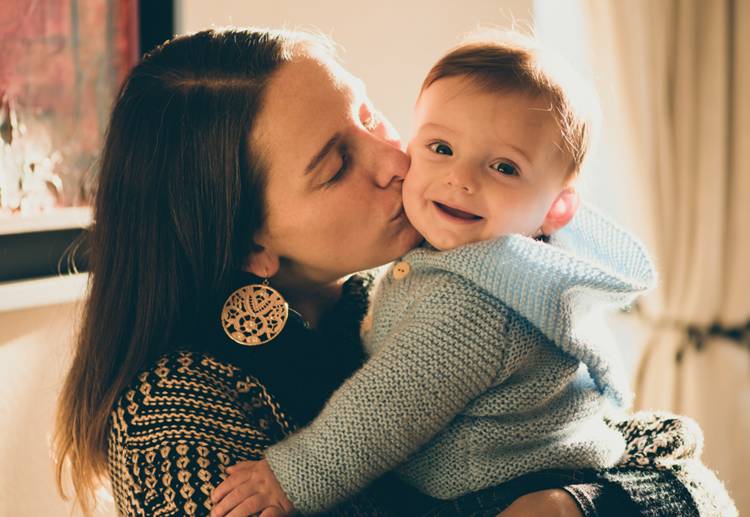
From a parallel process perspective, safeguarding the continued health and well-being of infants and toddlers is contingent on safeguarding the health and well-being of their families. Photo: Pablo Rogat/shutterstock
The unique and critical role of ECEs in fostering young children’s health and well-being underscores the need to attend to the wellness of ECEs. In fact, research suggests that indices of higher workplace stress are associated with ECEs’ greater burnout (Blöchliger & Bauer, 2018), as well as more conflict in relationships between ECEs and the children in their care (Whitaker et al., 2015). Moreover, lower income has been linked to ECEs’ more unhealthy behaviors and depressive symptoms (Linnan et al., 2017). Other studies suggest a link between ECEs’ report of depression symptoms and less sensitivity, as well as more withdrawal, toward the children in their charge (Jeon et al., 2014). Furthermore, studies suggest higher prevalence of indicators of fair/poor physical and emotional health among ECEs, relative to the U.S. national population of adult women (Linnan et al., 2017; Whitaker et al., 2013).
The Impact of COVID-19
Existing stressors have been compounded by the extraordinary circumstances of the COVID-19 pandemic (Child Care Aware of America, 2020). The pandemic has devastated an already vulnerable early childhood education system—taking a heavy toll on the livelihoods of ECEs, families, and the economy as a whole (Child Care Aware of America, 2020). COVID conditions are overlaid by social injustice and political unrest embedded in institutional racism and structural imbalances (Sethi et al., 2020).
On a national level, approximately 40% of ECEs are persons of color, with Hispanic ECEs over-represented in a lower status role (i.e., assistant teacher) and under-represented in the role of teacher (Center for the Study of Child Care Employment, 2018). Furthermore, data suggest that African American ECEs earn lower wages than their white counterparts (Center for the Study of Child Care Employment, 2018; Ullrich et al., 2016). Moreover, communities of color, low-income families, and children with special needs have historically had less access to affordable, inclusive, and high-quality early childhood education (Child Care Aware of America, 2020; Sethi et al., 2020). Given that under-resourced, marginalized communities may be disproportionately impacted by adverse social–economic forces (Gaynor & Wilson, 2020), the most disenfranchised on both ends of the educator–family equation might bear the brunt of the early childhood education industry crisis. Without decisive, equitable measures to invest in the early childhood education system—nationally, state-wide, and locally—the pandemic will continue to expose, perpetuate, and exacerbate systemic disparities and inequities.
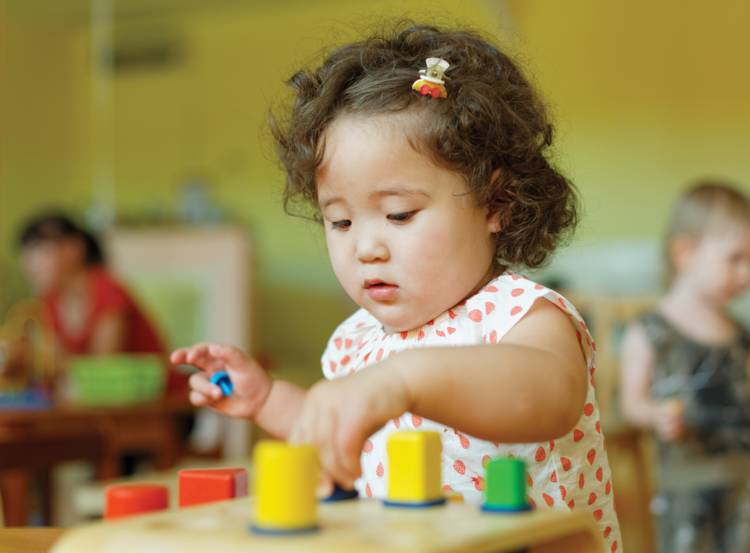
The first 3 years of a child’s life are uniquely important because this is the most sensitive period for brain development. Photo: Gaukhar Yerk/shutterstock
Nurturing the Nurturer
Promoting a robust and responsive early childhood education system that can withstand the pandemic and other social– economic threats requires a strong foundation, grounded in the knowledge, skills, cultural competencies, compassion, and other professional assets that shape and strengthen the profession. For ECEs to maintain the optimal quality and integrity of their daily practice, they too need to feel cared for on multiple levels.
Given that working with children and families can take a toll on both mind and body, programs might consider designating time and resources to foster and support opportunities for self-care, health, and wellness. ECEs use of mindfulness, for example, has been associated with lower depressive symptoms and lower conflict in ECE–child relationships (Becker et al., 2017).
Reflective supervision can play a critical role in buffering workplace stressors and promoting professional growth. From the lens of attachment and the construct of parallel process, responsive and attuned interactions in the ECE–supervisor relationship promote a secure base from which ECEs can spread their wings and foster safe and secure relationships with the children in their care. In addition to supervisors, perceived support from other program staff, such as administrators and peers, can contribute to ECEs’ perception of being respected in their work (Tukonic & Harwood, 2015).
While opportunities for wellness and support can serve as powerful resources for ECEs, concrete barriers to professional fulfillment need to be actively addressed. The theme of diminishment is a common thread that is woven throughout the ECE literature (Fernandez et al., 2018; Gerstenblatt et al., 2014; Tukonic & Harwood, 2015). Societal misconceptions of ECEs as “babysitters” (Tuominen, as cited in Gerstenblatt et al., 2014) continue to surface—devaluing ECEs’ contributions and potentially justifying low wages. A public education campaign, highlighting ECEs’ role in fostering and strengthening infant and early childhood mental health, could amplify the voice and standing of the profession.
In the interim, tangible and urgent concerns warrant both emergency measures and sustainable, systemic change. Just as “babies can’t wait,” neither can their dedicated caregivers and educators. Post-pandemic growth and recovery of the early childhood education system is contingent on economic safeguards and stability for everyone. Moreover, the early childhood system is a critical part of the infrastructure that our nation depends upon for families to be able to return to work and for businesses to thrive. ECEs are essential workers and filling in the yawning chasm between ECEs’ high-value work and low compensation calls for a strong interdisciplinary and cross-systems response (Allvin, 2020). Given the stakes for young children, families, and the larger society, change cannot come soon enough.
Conclusions
Infant and early childhood mental health and early childhood education are multidisciplinary fields and ECEs are well positioned to promote IECMH through their roles with the children and families in their care. ECEs, as caregivers of children for many hours each day, are key professionals in promoting and sustaining IECMH and contributing to social and emotional development. Early childhood education provides opportunities for children to expand their attachment relationships, express and explore emotions, and explore their environments and learn. ECEs and quality early childhood programs (both center- and family-based settings) have the potential to foster positive, trusting relationships with parents and caregivers and to be seen as an important and necessary community resource. Building positive relationships with families enables the ECE to support their concerns and to partner with their strengths. The role of the ECE in holding parents in mind so that those parents can provide optimal nurturing and attuned care to their young children is critical in upholding a caregiving environment that supports the optimal health and development of infants and young children.
Author Bios
Dorinda Silver Williams, PhD, LCSW-C, LICSW, is a licensed clinical social worker with a comprehensive background in infant and early childhood mental health, parent–child attachment, reflective practice, home visitation, family stress and trauma, and military social work. Dr. Williams is passionate about promoting secure parent–child attachments, building on family strengths, and fostering resilience in the context of trauma and loss. In her role as an assistant professor at Georgetown University’s Center for Child and Human Development, Dr. Williams has engaged in research and clinical work focused on implementation and evaluation of reflective practice models, integration of evidence-based interventions for young children and their families into multiple, innovative settings in the District of Columbia (DC), and assessment of perinatal services in DC.
Kathleen Mulrooney, director of infant and early childhood mental health (IECMH) strategy at ZERO TO THREE, is a passionate advocate and recognized thought leader in IECMH. She has virtually worked around the world and across the many systems of professionals who touch the lives of infants, young children, and their families. At the heart of her IECMH work is her deep commitment to core values of relationship, reflection, and learning from families from diverse backgrounds, knowledge, and experiences.
Suggested Citation
Williams, D. S., & Mulrooney, K. (2021). Guardians in the nursery: The role of early childhood educators in fostering infant and young children’s positive mental health. ZERO TO THREE Journal, 41(3), 10–16.
References
Ainsworth, M. D., Blehar, M. C., Waters, E., & Wall, S. (1978). Patterns of attachment: Assessed in the strange situation and at home. Lawrence Erlbaum.
Allvin, R. H. (2020). Making connections. Build it better: Child care after the COVID-19 pandemic. Young Children, 75(3). link
Becker, B. D., Gallagher, K. C., & Whitaker, R. C. (2017). Teachers’dispositional mindfulness and the quality of their relationships with children in Head Start classrooms. Journal of School Psychology, 65, 40–53. link
Blöchliger, O. R., & Bauer, G., F. (2018). Correlates of burnout symptoms among child care teachers. A multilevel modeling approach. European Early Education Research Journal, 26(1), 7–25. link
Bowlby, J. (1988). A secure base: Parent-child attachment and healthy human development. Basic Books.
Center for the Study of Child Care Employment (CSCCE), University of California Berkeley. (2018). About the early childhood workforce. link
Child Care Aware of America. (2020, Fall), Picking up the care pieces, building a better child care system post COVID-19. link
Coan, J. A. (2010). Toward a neuroscience of attachment. In J. Cassidy & P. R. Shaver (Eds.), Handbook of attachment: Theory, research, and clinical applications (2nd ed., pp. 241–268). Guilford Press.
Deery-Schmitt, D. M., & Todd, C. M. (1995). A conceptual model for studying turnover among family child care providers. Early Childhood Research Quarterly, 10, 121—143.
Fernandez, J., Mootoo, C. J., Romero, S., & Rasmussen, A. (2018). Role conflict among family childcare providers in the Bronx. Children & Society, 32, 470–480. link
Fraiberg, S., Adelson, E., & Shapiro, V. (1975). Ghosts in the nursery: A psychoanalytic approach to the problems of impaired infant-mother relationships. Journal of the American Academy of Child and Adolescent Psychiatry, 14(3), 387–421.
Gaynor, T. S., & Wilson, M. E. (2020). Social vulnerability and equity: The disproportionate impact of COVID-19. Public Administration Review, 80(5),832–838. link
Gerstenblatt, P., Faulker, M., Lee, A., Doan, L. T., & Travis, D. (2014). Not babysitting: Work stress and well-being for family child care providers. Early Childhood Education Journal, 42, 67—75. 10.1007/s10643-012-0571-4 link
Green, J., Stanley, C., & Peters, S. (2007). Disorganized attachment representation and atypical parenting in young school age children with externalizing disorder. Attachment and Human Development, 9(3), 207–222. link
Jeon, L., Buettner, C. K., & Snyder, A. R. (2014). Pathways from teacher depression and child-care quality to child behavioral problems. Journal of Consulting and Clinical Psychology, 82(2), 225–235. link
Laughlin, L. (2013). Who’s minding the kids? Child care arrangements: Spring 2011. Current Population Reports, P70-135. U.S. Census Bureau. link
Lieberman, A. F., Padrón, E., Van Horn, P., & Harris, W. W. (2005). Angels in the nursery: The intergenerational transmission of benevolent parental influences. Infant Mental Health Journal, 26, 504–520.
Linnan, L., Arandia, G., Bateman, L. A., Vaughn, A., Smith, N., & Ward, D. (2017). The health and working conditions of women employed in child care. International Journal of Environmental Research and Public Health, 14(283), 1–14. link
National Association for the Education of Young Children (NAEYC). (2019). Professional standards and competencies for early childhood. link
National Scientific Council on the Developing Child. (2010). Persistent fear and anxiety can affect young children’s learning and development, Working paper No. 9. link
Sagi, A., van IJzendoorn, M. H., Aviezer, O., Donnell, F., Koren-Carie, N., Joels, T., & Harel, Y. (1995). Attachments in a multiple-caregiver and multiple-infant environment: The case of the Israeli kibbutzim. Monographs of the Society for Research in Child Development, 60(2-3, Serial No. 244), 71–91.
Sethi, S., Johnson-Staub, C., & Robbins, K. G. (2020, July). An anti-racist approach to supporting child care through COVID-19 and beyond. link
Siegel, D. J. (1999). The developing mind: How relationships and the brain interact to shape who we are. Guilford Press.
Sisson, S. B., Smith, C. L., & Cheney, M. (2017). Big impact on small children: Child-care providers’ perceptions of their role in early childhood healthy lifestyle behaviors. Child Care in Practice, 23(2), 162–180. link
Tukonic, S., & Harwood, D. (2015). The glass ceiling effect: Mediating influences on early years educators’ sense of professionalism. Journal of the Canadian Association for Young Children, 40(1), 36–54.
Ullrich, R., Hamm, K., & Herzfeldt-Kamprath, R. (2016, August). Underpaid and unequal: Racial wage disparities in the early childhood workforce. Center for American Progress. link
Vaughn, B. E., & Waters, E. (1990). Attachment behavior at home and in the laboratory: Q-Sort observations and Strange Situation classifications of oneyear-olds. Child Development, 61, 1965–1973.
Waters, E. (2008, November). Attachment theory, the secure base concept and script-like attachment representations. Presented at the Washington School of Psychiatry, Washington, DC.
Whitaker, R. C., Becker, B. D., Herman, A., N., & Gooze, R., A. (2013). The physical and mental health of Head Start staff: The Pennsylvania Head Start staff wellness survey, 2012. Preventing Chronic Disease, 10. link
Whitaker, R. C., Dearth-Wesley, & Gooze, R. A. (2015). Workplace stress and the quality of teacher–children relationships in Head Start. Early Childhood Research Quarterly, 30, 57–69.
ZERO TO THREE. (2016). DC:0–5TM: Diagnostic classification of mental health and developmental disorders of infancy and early childhood.
ZERO TO THREE Infant Mental Health Task Force Steering Committee. (2001). Definition of infant mental health [internal report]. ZERO TO THREE.



